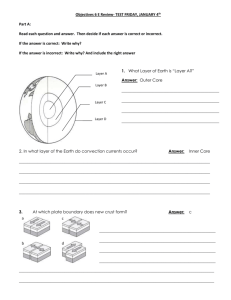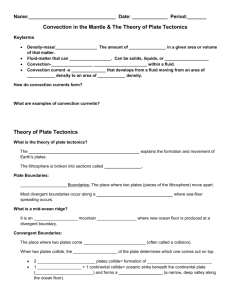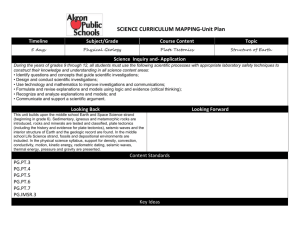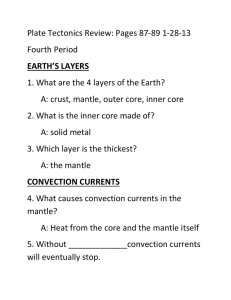Dynamic Model of Paired Convection Cells
advertisement
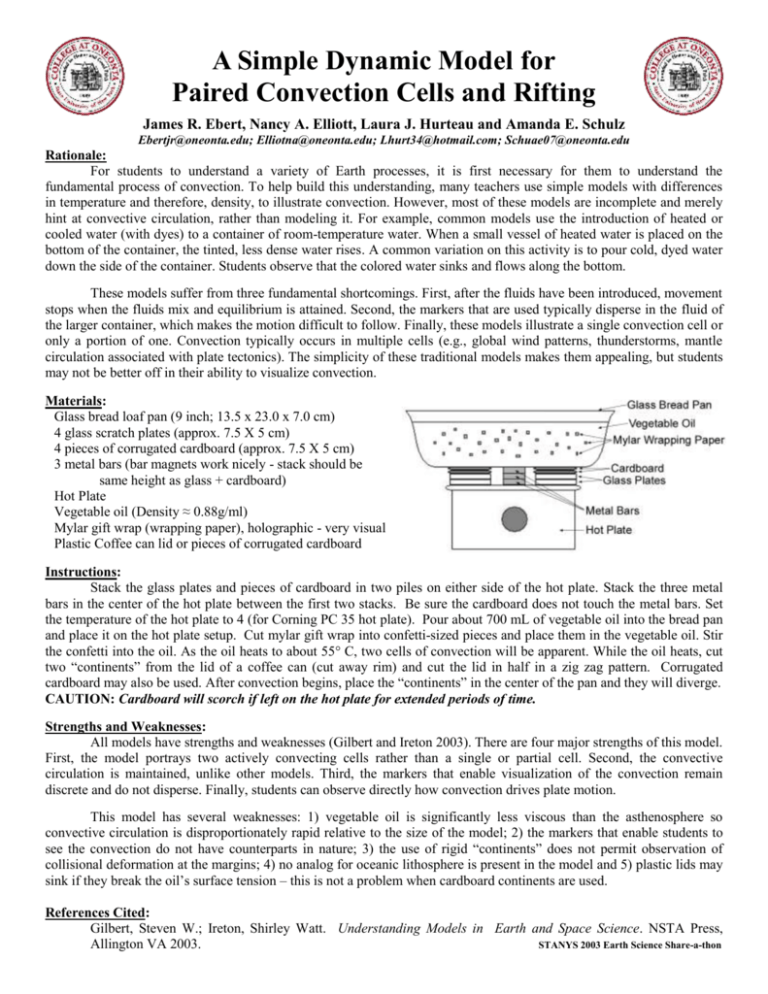
A Simple Dynamic Model for Paired Convection Cells and Rifting James R. Ebert, Nancy A. Elliott, Laura J. Hurteau and Amanda E. Schulz Ebertjr@oneonta.edu; Elliotna@oneonta.edu; Lhurt34@hotmail.com; Schuae07@oneonta.edu Rationale: For students to understand a variety of Earth processes, it is first necessary for them to understand the fundamental process of convection. To help build this understanding, many teachers use simple models with differences in temperature and therefore, density, to illustrate convection. However, most of these models are incomplete and merely hint at convective circulation, rather than modeling it. For example, common models use the introduction of heated or cooled water (with dyes) to a container of room-temperature water. When a small vessel of heated water is placed on the bottom of the container, the tinted, less dense water rises. A common variation on this activity is to pour cold, dyed water down the side of the container. Students observe that the colored water sinks and flows along the bottom. These models suffer from three fundamental shortcomings. First, after the fluids have been introduced, movement stops when the fluids mix and equilibrium is attained. Second, the markers that are used typically disperse in the fluid of the larger container, which makes the motion difficult to follow. Finally, these models illustrate a single convection cell or only a portion of one. Convection typically occurs in multiple cells (e.g., global wind patterns, thunderstorms, mantle circulation associated with plate tectonics). The simplicity of these traditional models makes them appealing, but students may not be better off in their ability to visualize convection. Materials: Glass bread loaf pan (9 inch; 13.5 x 23.0 x 7.0 cm) 4 glass scratch plates (approx. 7.5 X 5 cm) 4 pieces of corrugated cardboard (approx. 7.5 X 5 cm) 3 metal bars (bar magnets work nicely - stack should be same height as glass + cardboard) Hot Plate Vegetable oil (Density ≈ 0.88g/ml) Mylar gift wrap (wrapping paper), holographic - very visual Plastic Coffee can lid or pieces of corrugated cardboard Instructions: Stack the glass plates and pieces of cardboard in two piles on either side of the hot plate. Stack the three metal bars in the center of the hot plate between the first two stacks. Be sure the cardboard does not touch the metal bars. Set the temperature of the hot plate to 4 (for Corning PC 35 hot plate). Pour about 700 mL of vegetable oil into the bread pan and place it on the hot plate setup. Cut mylar gift wrap into confetti-sized pieces and place them in the vegetable oil. Stir the confetti into the oil. As the oil heats to about 55° C, two cells of convection will be apparent. While the oil heats, cut two “continents” from the lid of a coffee can (cut away rim) and cut the lid in half in a zig zag pattern. Corrugated cardboard may also be used. After convection begins, place the “continents” in the center of the pan and they will diverge. CAUTION: Cardboard will scorch if left on the hot plate for extended periods of time. Strengths and Weaknesses: All models have strengths and weaknesses (Gilbert and Ireton 2003). There are four major strengths of this model. First, the model portrays two actively convecting cells rather than a single or partial cell. Second, the convective circulation is maintained, unlike other models. Third, the markers that enable visualization of the convection remain discrete and do not disperse. Finally, students can observe directly how convection drives plate motion. This model has several weaknesses: 1) vegetable oil is significantly less viscous than the asthenosphere so convective circulation is disproportionately rapid relative to the size of the model; 2) the markers that enable students to see the convection do not have counterparts in nature; 3) the use of rigid “continents” does not permit observation of collisional deformation at the margins; 4) no analog for oceanic lithosphere is present in the model and 5) plastic lids may sink if they break the oil’s surface tension – this is not a problem when cardboard continents are used. References Cited: Gilbert, Steven W.; Ireton, Shirley Watt. Understanding Models in Earth and Space Science. NSTA Press, Allington VA 2003. STANYS 2003 Earth Science Share-a-thon




